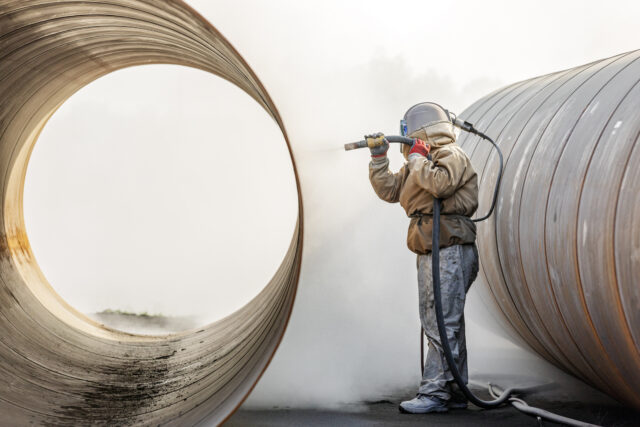Spray coating is the coating of a material with a spray while the object to be coated spins at a low speed for uniform coating. Spraying usually involves a nozzle where a liquid is forced under pressure to create tiny atoms that can get deposited on a surface. Spraying has several advantages like a smoother finish, less wastage of spraying material, etc.
The material that is sprayed might make a surface resistant to high temperatures or to UV rays.
Thus this technique has wide applications in many industries like the automobile manufacturing industry, medical device manufacturing industry, etc. The coated solids can have other desirable characteristics like resistance to scratching, smoothness to touch, protection against fog or light reflection, etc. Hence spray coating has become a preferred choice for manufacturers across industries.
Spray coating might have several advantages, but like all manufacturing processes, it also has some challenges, and a few do’s and don’ts should be kept in mind to get optimum results.
3 Spray Coating Tips: Some Do’s And Don’ts
Clogging Of Pores And Uneven Coating
Nozzles have tiny pores through which the liquid comes out as a mist. The mist is usually created by pressurized air and a liquid that is to be deposited. The mixing happens close to the nozzle. When the liquid somehow solidifies or crystallizes, then it might close the blocking of the nozzle.

If the passage is blocked, the mist creation is affected. This, in turn, can cause the coating to be uneven, affecting the overall look and the texture of the object. Apart from this, proper dilution of the liquid results in a smooth layer.
Thus, crystallization and blockages can drastically reduce the efficiency of the nozzle. The jams usually happen at the tip of the passage because the end is highly narrow in size. The size of the nozzle tip is smaller than a millimeter. Also, since the nozzle is the first point where the liquid to be sprayed comes in contact with air, it has a high chance of getting solidified if it has some adhesive substance mixed in it.
Hence it is vital to be careful to prevent clogs or remove them effectively if they occur to improve the efficiency of the manufacturing process. The simplest thing to do is to wipe the tip to remove any solid clog that may have accumulated. Changing the parameters of the spray gun is another option.
The nozzle diameter that creates the optimum atomization might need a lot of optimization. Hence trying a larger diameter might give more space for the liquid to flow without compromising on the mist formation. Round-type guns reduce the chance of clogs; however, they utilize more power.
Introducing a time lag between successive batching of casting or soaking the air cap in cleaning fluid after a few batches of atomization are good practices. Also, the viscosity of the liquid matters; if the density is less and the nozzle is very close to the object, then there are chances that the tip can be damaged due to the bounce back of the liquid. Thus, the distance and the angle at which the mist is applied have to be adjusted to prevent bouncebacks.

The length of the path a liquid travels has to be based on viscosity. If the fluid is highly viscous and the course it has to traverse is long, then it might not even reach the tip effectively. Likewise, workers should be careful before deploying multiple spray guns, as the liquid might reach up to all the guns. Hence it is a good idea to stick to a maximum of three or four guns per tank of pressurized fluid.
The presence of dirt, dust, etc. can also cause contaminations and stoppages hence keeping the working premises clean and free of dust prevents accidental contaminations.
Preventing Damage To The Equipment
Damage to equipment increases the overall cost of production as the repair and replacement costs increase. Apart from the maintenance costs, damaged equipment gives a subpar performance which eventually affects the quality of the final product. Erosion and corrosion are the most common damages. Filtering the fluid before use significantly lowers the repair and replacement costs.
Accidental installation of parts might cause increased friction and improper weight balance, which eventually lowers the longevity of the equipment. Hence, workers must be trained on proper installation and usage practices to improve the longevity of the apparatus.
Safety Measures For Preventing Health Hazards And Fires
The liquids dispensed as a mist might be toxic for inhalation or damage the skin if it comes in contact with it. Hence it is crucial to avoid inhalation or direct contact with adhesives, industrial solvents, etc.

The premises should be well ventilated, and workers should wear PPE kits if the liquid to be sprayed is toxic. Wearing protective goggles, face masks, or body aprons lowers the chances of direct exposure to toxic chemicals. Also, if any worker shows symptoms like dizziness or breathing trouble, they should immediately be hospitalized.
Some paints and adhesives may catch fire easily; hence the atomized fluid that comes out should be kept away from any source of the fire.
Conclusion
There are companies that offer customized and precise spray casting for the aviation industry, electronic goods industry, etc. With the increased complexity of designs for goods, spraying techniques have become more sophisticated to match the demand from the industry. Thus, the spraying techniques today create a strong bond between the object and the sprayed material. They have high deposition efficiency that gives an excellent finish.
Today spray casting can work with a wide range of fluids and is being applied on a wide range of surfaces, including wood, metal, fiberglass, etc. The atomization process can be fine-tuned to a great extent and speed has improved considerably, and large surfaces can be coated in less time. Following the excellent working practices mentioned above can further enhance the efficacy of the process.








